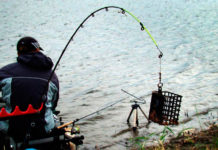Fishing shops today are literally inundated with various tackle. These are spinning rods and feeders, blanks for carp, flywheels, bolognese and plug. Various additional pieces are offered to them, designed to make fishing more effective: rings and reels, leashes, fishing lines, wobblers and spinners. But the main thing is the fishing rods themselves, of different order, dough, purpose, made of modern materials. bestx.htgetrid.com/en/ offers a review of the Best Carbon Rods for 2020, based on the opinions of buyers and experienced anglers.
Content
- 1 What do we know about carbon
- 2 Benefits of carbon rods
- 3 Material marking
- 4 Rod selection criteria
- 5 Differences in design
- 6 What to look for
- 7 Top Carbon Rod Manufacturers
- 8 Where can I buy
- 9 How to repair a carbon rod with your own hands
- 10 Rating of quality carbon rods
What do we know about carbon
It seems, quite recently, fishermen could only choose between bamboo and homemade fishing rods, carved from more or less suitable branches of maple or hazel. Today in stores you can buy rods made of fiberglass (fiberglass), carbon, composite products (various combinations of carbon and fiberglass).
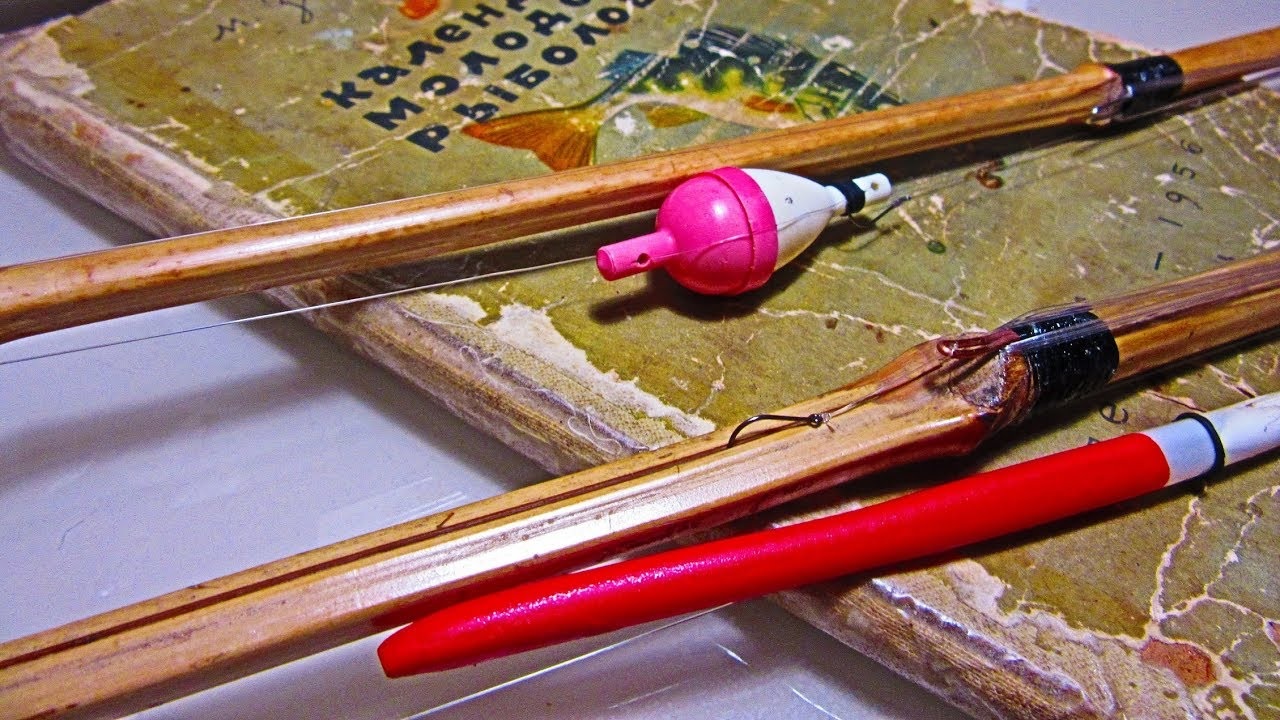
The most modern rods are made of carbon (aka graphite or carbon fiber). Tackle manufacturers, not sparing paints, describe the outstanding characteristics of their products (whips, sticks, blanks), their super strength and unprecedented elasticity. The buyer has to take all this on faith, since it is impossible to determine the strength and elasticity indicators by eye. In addition, carbon fiber manufacturers receive patents for their developments and do not share their secrets. We can only advise users not to buy cheap whips from unknown manufacturers.
Interesting! Carbon is called a fabric made of carbon fibers obtained by artificial means. To give the products excellent performance characteristics, the fabric is treated with polymer resins.
The starting material is polyacrylonitrile polymer (PAN), which has passed the stages of heat treatment and carbonization. In this way, ultrafine threads are obtained with a cross section of 0.005 to 0.1 mm. These threads are called "carbon fiber" or pure carbon. They are used to produce fabric, reinforcing it with a frame made of various polymer resins. It's carbon fiber. From this fabric, rods are made, giving them shape and fixing it with epoxy resins. Over time, confusion has formed in these definitions. For most buyers, the concepts of carbon and carbon fiber have merged into one. To understand the difference between a carbon rod and a carbon fiber rod, it is enough to know that carbon is the material for producing carbon fiber.

Benefits of carbon rods
Carbon fiber products have remarkable performance characteristics:
- high strength;
- rigidity;
- extreme ease.
All these magical qualities can vary depending on the direction of the fibers of the fabric and the material of the reinforcement. By changing the weaving pattern, you can achieve different degrees of elasticity and strength of products.Thus, with the advent of carbon, the specialists of companies specializing in the production of fishing tackle have the opportunity to create fishing rods with ideal characteristics.
The process of obtaining carbon is technically very complex and laborious. This is a very expensive material.
On a note! One kilogram of carbon fiber costs $ 20. The production of one kilogram of steel costs no more than one dollar.
The high cost is the only drawback of this material. If you are offered a cheap carbon fiber rod, know that something is wrong with it!
Material marking
Carbon is marked with the letter "K" and the numbers 1, 2, 3, etc. This designation encodes the characteristics of a fabric woven from plates recruited from carbon threads.
Important! The number next to the letter "K" indicates the number of thousands of threads in one strip of fabric.
Thus, 2K means that each strip of which the carbon fabric is woven consists of 2000 threads, 1K - of 1000 threads, etc. The information is of course interesting, but it gives little to the buyer, since it is not the number of threads in the strip that is much more important, but the method of weaving and the composition of the fibers.
Some manufacturers, instead of the letter K, mark their products IM with a certain number after the letter combination, giving this designation as a certain modulus of elasticity. Moreover, the larger the number in front of IM, the “cooler” the stick. Quite frankly, such labeling is a marketing technique, and not the most "clean" one. However, it is used by some European manufacturers, placing their orders at "second-rate" Chinese factories in order to "sell" not the best product to a not very discerning buyer.
In fact, American carbon fiber manufacturers label their products with IM. The most common are IM6, IM7. Good, and sometimes very good whips and sticks are made from such a canvas. But this designation has nothing to do with the characteristics of the fishing rod. This is only a brand of carbon fiber. It cannot determine the quality of the product.
On a note! IM - short for "intermediate modulus fiber", in translation - fiber of medium elasticity.
Rod selection criteria
To understand how to choose a worthy stick and what to pay attention to, let us recall its main estimated parameters:
- Class.
- Build.
- Test.
- Material.
Each of the listed parameters requires more detailed consideration.
Class
The characteristic is interesting in that it has different meanings for sticks for various purposes. The simplest class definition applies when considering float rods. In this fishing tackle sector, class membership depends on the length and weight of the blank:
- Light (Light). Weight does not exceed 150 g, length - not more than 2500 mm.
- Medium (Medium light). Not heavier than 250 g and up to 5000 mm.
- Heavy sticks (Heavy). Up to 300 g and over 6000 mm.
The classes of spinning whips depend on the mass of the used wobbler or lure, i.e. determined by the whip test. Unlike leisurely fishing with a float rod, spinning fishing is a very active process. Success here depends on the accuracy of the casting and the sensitivity of the rod to the bite. There are seven classes of spinning rods:
- Super Light or Ultra light (UL). The bait is not heavier than 7.0 g.
- Light or Light (L). The bait weighs between 3 and 14 g.
- Medium Light or Medium Light (ML). The weight of a wobbler or spinner ranges from 5 to 20 g.
- Medium (M) or middle class. The bait is used from 10 to 30 g.
- Medium Heavy (MH) - medium weight, i.e. wobbler weight within 15 - 40 g.
- Heavy (H). Heavy. The bait weighs between 20 and 50 g.
- Extra Heavy (EH). Extremely heavy class, used with bait weighing up to 60 g.
Feeders are classified according to the test, taking into account the weight of the feeder:
- Lightweight, with dough no more than 40 g and a feeder weight up to 30 g.
- Medium - from 40 to 80 g.
- Heavy - 80 to 120 g.
- Extra heavy - over 120g.
Rod construction
The parameter shows the flexibility of the stick depending on the applied load. More specifically, action shows the buyer how much the rod bends and how quickly the rod tip will return to its original shape after the load is removed. There are five types of tuning:
- Fast.A third of the blank is bent. After release from the load, the geometry is restored.
- Medium Fast. More than a third of the whip is bent, but not half. The original form does not return as quickly as with a fast action.
- Medium, or medium tuning. Half of the stick is bent.
- Slow - slow tuning. The rod will bend along its entire length, taking the form of a parabola, for which these rods are called parabolics. The return to the previous form will occur after some time.
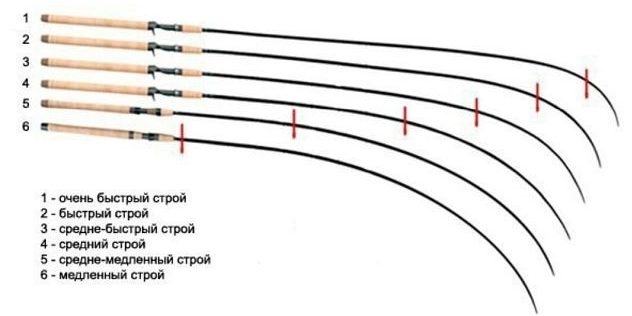
Important! Each system has its own advantages. Fast - stronger, slower compensates for the load on the hand from jerking when playing especially large trophies.
Test
This parameter determines the maximum and minimum bait weight for which the tackle is designed. If you see the designation 10-30 on the body of the form in combination with the letter G, be aware that a wobbler weighing less than 10 grams will not allow you to accurately cast it where, according to all signs, there should be fish, and when jigging you will not be able to feel that the bait touched the bottom. If you use a spoon weighing more than 30 grams, the product will not last long. It would be best to choose lures in the middle range, without applying extreme values of the allowed weight.
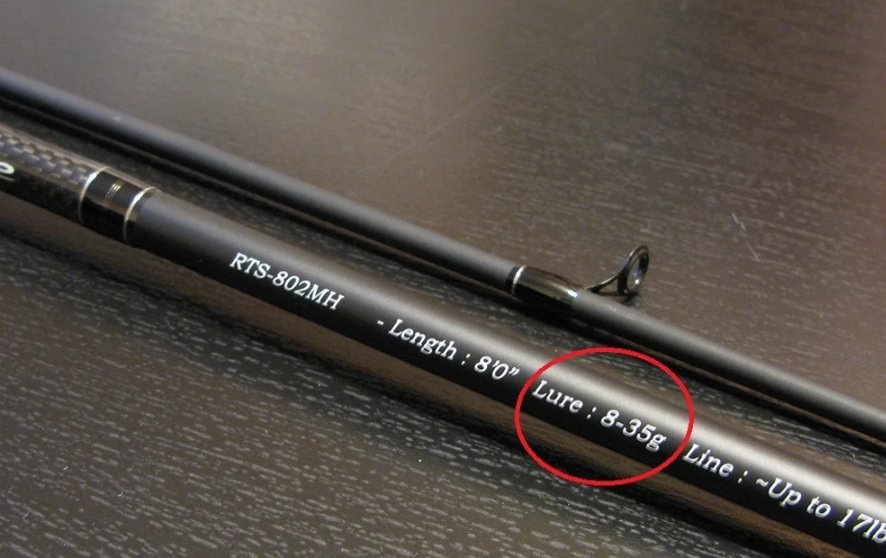
Rod balance
Manufacturers of quality tackle must include the balancing operation of their products in the technological chain. This parameter determines how comfortable fishing will be, and how quickly the owner's hand gets tired. The characteristic is verified in a simple "old-fashioned" way. The blank is taken with the working hand (right or left) so that the spool leg is between the middle and ring fingers. The hand relaxes and the product lies horizontally on the fingers. Then only one finger is left under the stick. If the whip is kept horizontal and does not peck, it is normally balanced.
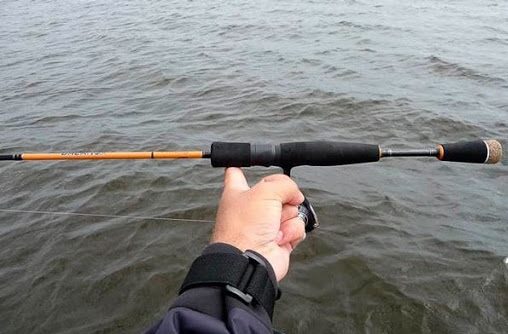
Important! The rod balance is checked only with the reel.
Balancing can be corrected by changing the position of the coil. Attempts to make the handle or blank heavier will do nothing but increase the total weight of the tackle. As a result, fishing arm gets tired faster.
Differences in design
Depending on the chosen fishing method, the characteristics of the reservoir and the availability of a boat, the design of the rods is also chosen. Consider what they are.
Single-piece or solid
Everything is simple here. One stick that doesn't fold out or fold. Most often it is used as a float rod, i.e. a fishing line with a float, a sinker and a hook is attached to its top. The stick is sold without rings. Its length depends on how you will fish: from the shore, from a boat or by wading (wading into the water, as far as the height of rubber boots allows).
A one-piece whip will be good as a jerk rod for powerful spinning. The length of the stick for this wiring method does not reach two meters.
Interesting! Jerking is called catching a large predator with a heavy wobbler. Wiring differs from twitching by sharp jerks. A fast action blank with a baitcasting coil is used.
Special one-piece whips are made for winter fishing. In order to fish from the ice in the hole, a long rod is not required. On the contrary, the shorter the stick, the better.
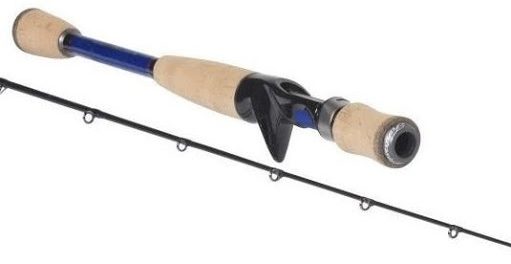
Plug
Consist of several knees that are worn one on top of the other. The minimum number of sticks is two. It is often used as a spinning rod for fly fishing, as a Bolognese or match tackle, as well as for sports.
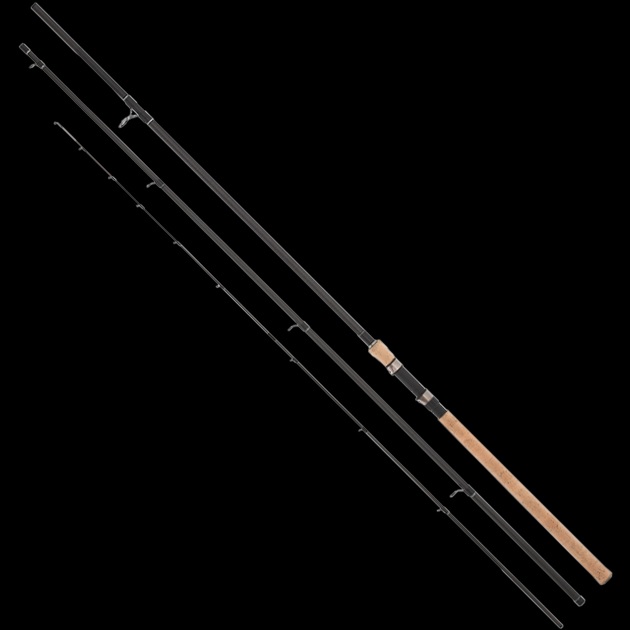
Telescopic
Not a bad option for novice fishermen in any kind of "quiet hunt". Several knees are folded into one another. On the pond, they move forward, assuming working dimensions, ranging from 2.5 to 11 meters. They are very convenient for transportation, because they take up little space. Equipped with line rings, spools.
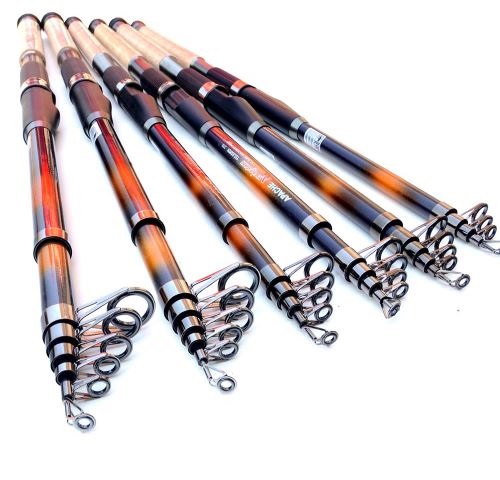
What to look for
The rod is selected. You can pay for the purchase and fly to the nearest body of water for testing. There is no need to rush. Follow a few simple steps:
- Carefully inspect the blank from the handle to the tip for damage, cracks, chips, irregularities, and even scratches. Special attention to the top knee and top. Damage to these areas will cause your whip to lose its functionality prematurely.
- Shake the rod lightly and listen for any crunch or crackle. If there is, return the product to the seller and look for another.
- Simulate bending under load with the seller and inspect it again for micro cracks.
- Examine the inserts in the rings. The presence of scratches on their surface is unacceptable. The line will break frequently.
Top Carbon Rod Manufacturers
The vast majority of rods on the market are of Asian origin. The most famous brands today are engaged in the development of equipment and technology. Then, when the documentation is ready, a contract is concluded with the OEM company.
On a note! OEM or Original EQUIPMENT Manufactures translates as “manufacturing of original products.
Often, an OEM company can produce products of several world brands, but with the mark Made in China. It happens that a company makes a semi-finished product and sends it to the brand owner for revision. In this case, the buyer purchases a product labeled, for example, Made in USA or Germany.
Daiwa
A well-known Japanese fishing tackle company. On the market since 1945. Today the company has its branches in South Korea, China, Taiwan and Hong Kong, Thailand and Scotland, sales offices in France and Germany. The popularity of its models among fishermen around the world is due to the amazing quality and durability, regardless of the cost of the product.
Zhibo
The brand is owned by the largest Chinese corporation Beijing Hairan Import & Export Trading Co., Ltd. In addition to its models, the company supplies components for the famous Japanese companies Ryobi and Shimano. The company's popular models represent the perfect combination of price and quality. If you are looking for a Chinese-made fishing rod, take a look at the Zhibo models.
Balzer
German manufacturer of fishing tackle. Founded in 1949. Quality products of the company are suitable for fishing in any known way and are in high demand all over the world.
Shimano
The Japanese company gained worldwide fame as a bicycle manufacturer. Since 1971, the corporation has been producing fishing tackle. Today, its products are very popular in Europe, Asia and America, due to their high quality and affordable prices. Shimano rods are among the best in the world according to experienced anglers.
Mikado
Polish company founded by several fishing enthusiasts. On the market since 1989. Three years later, her products hit the domestic counter and immediately began to enjoy increased demand due to their consistently good quality. Budget prices.
Salmo
The company was founded in 1991 in Poland thanks to two avid fishermen - ichthyologists, Piotr Piskorski and Rodoslav Zavorski. It is their knowledge of ichthyology that helps them create products that are in demand among fishing enthusiasts.
The list of the best can be continued for a long time. It is up to you which company to buy the goods. First of all, you need to collect all the information about the manufacturer, study the description of the selected model, its characteristics. It is advisable to listen to the advice and recommendations of experienced fishermen. After that, it remains to find out how much the stick costs and pay off the seller.
Where can I buy
Your best bet is to shop at a specialist store. Here you can see, touch and comprehensively evaluate the new rod, get full advice from the seller. If, for some reason, this option is not feasible, it remains to order the form online in the online store. It will be more convenient and cheaper to make a deal with AliExpress and get the goods from China.
Yandex Market is a fairly convenient Internet platform. Here you can familiarize yourself with the description and characteristics of the goods and place an order in one of the many online stores.
How to repair a carbon rod with your own hands
The most durable product can break. Experienced fishermen advise against throwing away the debris immediately. Something can be left and used as spare parts in the future. With regard to maintainability, in the event of an "accident" the owner independently makes a decision: you can make repairs at home, take your whip to the master or send it to the trash heap.
The most common breakages are cracks or complete fractures of a knee or section. In this case, a tube of suitable diameter is selected, which enters the inside of the broken knee at the fracture site, without increasing the cracks. If necessary, it is processed by adjusting the outer diameter to the desired size. Then a two-component epoxy resin is prepared, the workpiece is processed and inserted into the fracture so that a part of the glue hits the inner surface of the broken tube. Then a second piece is put on the free end of the workpiece and the ends of the broken tube are brought together tightly until the gap is eliminated.
When the first part of the repair work is completed, they proceed to the second stage - strengthening the fault. To do this, a rectangular piece of carbon fiber or fiberglass of a suitable thickness is harvested, immersed in the prepared epoxy, squeezed and wrapped around a break (bandage is applied). The reinforcement is fixed with a flat tape.
Interesting! Some masters suggest fixing the bandage with film and leaving it on the processed fracture forever.
The product repaired in this way will serve for a long time without losing its working qualities.
Rating of quality carbon rods
One-generation
3.Zhibo Irian Casting 1.8 m / 50 - 150

Super heavy grade casting carbon blank. One-generational. Designed for casting lures weighing from 50 to 150 g (test). Advanced functionality allows you to use different baits, use different fishing methods. Provides comfortable playing of fish.
Stick length - 185 mm, weight - 175 g. Average price - 1990 rubles.
Advantages:
- lasting;
- highly sensitive;
- inexpensive.
Disadvantages:
- it is difficult to work with light baits.
2.Mikado Essential Bait Jerk 160
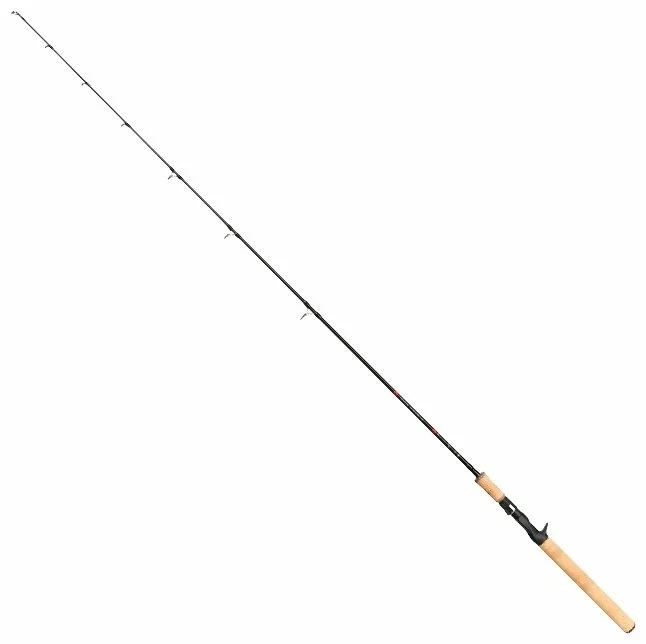
Jerk model from a Polish brand, heavy class with dough from 30 to 60 g, very fast action. Single-generation, 1600 mm long, 138 g weight. It is made of IM 9. Carbon cloth. Equipped with rings with silicon carbide inserts. An excellent whip for playing large predators. The average cost is 3014 rubles.
Advantages:
- durable;
- tough;
- lung;
- affordable price.
Disadvantages:
- not identified.
1.Salmo Ballist 1,8 m M-Heavy (TSBA3 - 591F)
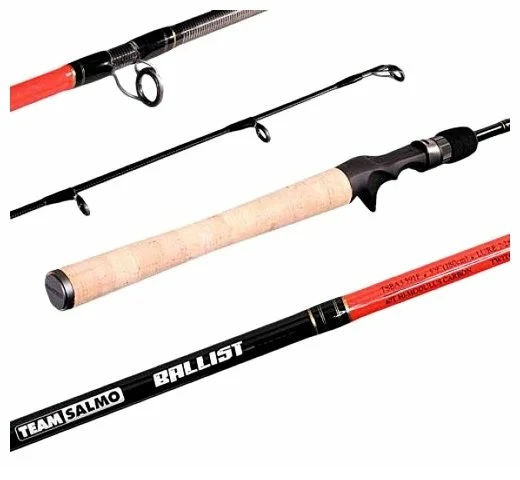
Spinning rod of the middle class with a test from 7 to 20 g, fast action. Whip length 1.8 m, weight 114 g with Zero Tangle rings. The material was 40T HI-modulus Carbon. The average price is 9313 rubles.
Advantages:
- very durable;
- extremely lightweight;
- optimal length.
Disadvantages:
- high price.
Telescopic
3.Salmo Elite Bolognese Medium M 600
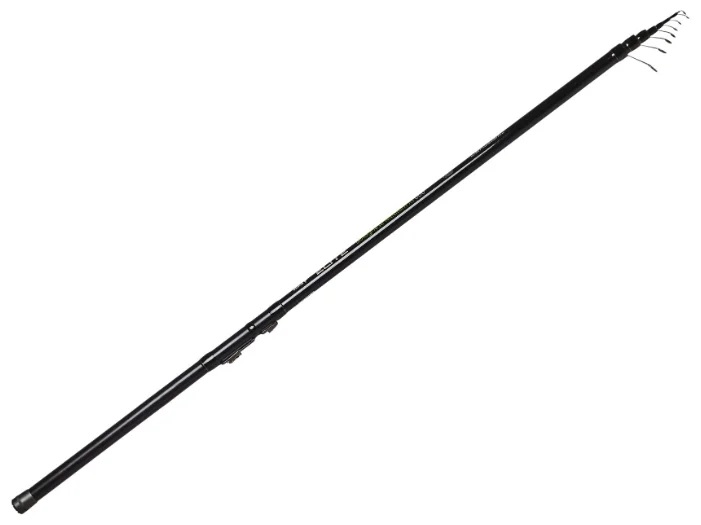
Medium-class telescopic Bologna rod, medium-fast action. Designed for fishing with light lures, ranging from 3 to 20 g (test). The working length of the blank is 6000 mm, folded - 1230 mm. All six sections of the product are made of T30 carbon fiber and equipped with rings with SIC inserts. The model is equipped with a CLIP UP reel seat. Average cost: 4528 rubles.
Advantages:
- strength and flexibility;
- versatile fishing possibilities;
- high quality materials and workmanship;
- affordable price.
Disadvantages:
- not identified.
2.Micado Lexus Tele Match 420
![]()
Match blank, middle class, telescopic design, with a maximum test of 25 g. Working length is 4.2 m, when folded - 1.12 m. Weight is 213 g. Composed of eight sections, equipped with rings with SIC inserts, protecting the line from fast abrasion. The sections are made of IM-9 carbon fiber. The average price is 6239 rubles. Great tackle for float fishing.
Advantages:
- durable and lightweight;
- long enough;
- convenient to carry.
Disadvantages:
- not for beginners.
1.Black Hole Atomic Bolo 600

The Bologna form from a well-known South Korean manufacturer receives the best reviews. Telescopic, 6000 mm long, weighing 235 g.Each of the seven sections is fitted with abrasion resistant silicon carbide (SiC) rings. Equipped with a Fuji reel seat. The minimum weight of the bait (test) is 134 g. The maximum depends on the number of sections and in our case is equal to 254 g. The average price is 12332 rubles. The Black Hole Atomic Bolo is a new addition to the company's Bolognese rod range.
Advantages:
- durable and lightweight;
- comfortable when fishing;
- convenient for transportation;
- made of high quality materials.
Disadvantages:
- expensive.
Plug
4.Ryobi Oasys 2/7 / 3-15
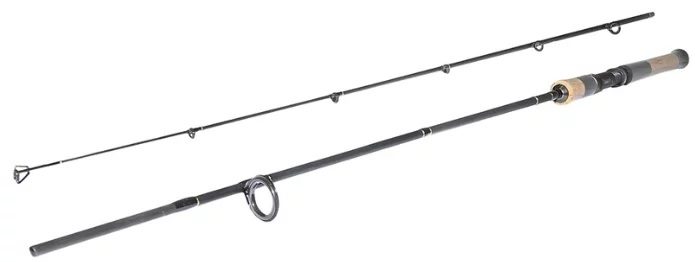
Spinning rod from a famous Japanese manufacturer, light class, medium-fast action, plug. It works with light lures from 3 to 15 g. In the assembled position it reaches a length of 2700 mm, when folded - 1390 mm. Very lightweight, only 155 g. Both sections are made of carbon fiber. The average cost of the product is 3,100 rubles.
Advantages:
- durable and lightweight;
- flexible;
- high casting accuracy;
- comfortable fishing for a trophy;
- affordable price.
Disadvantages:
- not identified.
3.Micado Archer Heavy Match 420
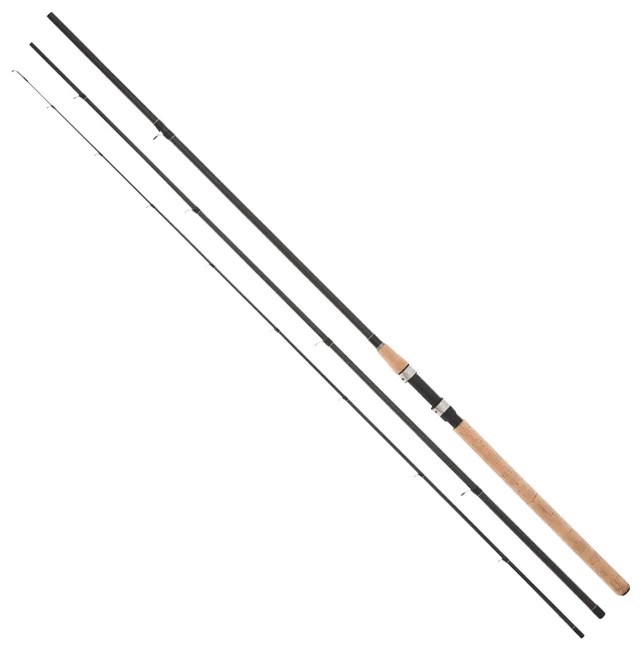
By design - a middle class match model, slow action, plug, with a maximum test of 30 g. When assembled it has a length of 4200 mm, during transportation - 1460 mm. Three sections are equipped with SIC rings. The handle is cork. The material of the sections is carbon fiber. The weight of the product is 263 grams. The average cost is 4172 rubles.
Advantages:
- flexible;
- lasting;
- reliable on fishing;
- convenient for transportation;
- affordable.
Disadvantages:
- not identified.
2.Balzer Shirasu Pro Staff Senso Zander 265
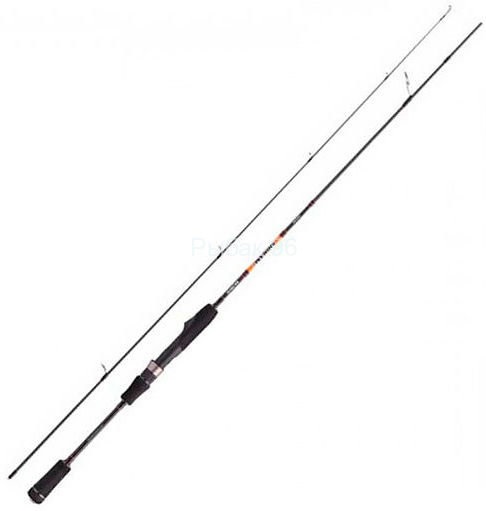
Spinning whip, plug, two-section, weight 184 g, length 2650 mm. Designed for casting lures with a minimum weight of 14 g. The maximum test does not exceed 38 g. The handle made of ethylene vinyl acetate (EVA) is lightweight and practical. The apex is tubular, flexible and sensitive. The IM 12 carbon fiber sections are strong and resilient. When folded, the length of the product is 1400 mm. Spinning has proven itself excellently in trout fishing. Its average cost is 8626 rubles.
Advantages:
- light weight;
- good flexibility;
- high strength.
Disadvantages:
- high price.
1.Shimano Beastmaster FX Predator 240L

The Shimano Beastmaster FX Predator 240L spinning whip is considered one of the best among the plug models. Light class and medium-fast action, designed for casting light baits, from 3 to 14 g. In working condition, its length is 2400 mm, and during transportation - 1080 mm. Carbon cloth of the ХТ60 + Nano brand provides excellent lightness of the product. Its weight is only 121 g. Sections are equipped with steel guides, Shimano Custom reel seat. The average cost of the model is 12,200 rubles.
Advantages:
- lasting;
- lightweight and flexible;
- accurate casting;
- comfortable playing the catch.
Disadvantages:
- high price.
They say that the time spent on fishing is not counted in the calculation of the years allotted for life. In other words, fishing prolongs life. A correctly selected rod provides the fisherman with comfort while driving and playing fish, therefore, enhances the health effect of this useful and enjoyable activity. The editors of the site hope that our review will help the buyer to choose the right rod and not make mistakes when choosing.


